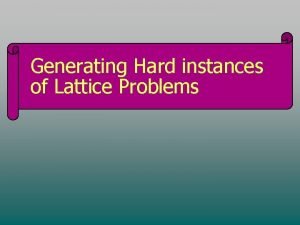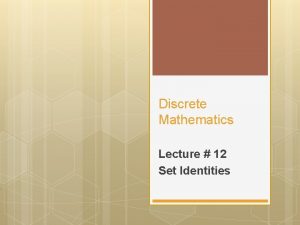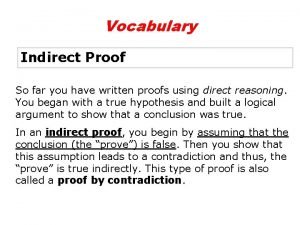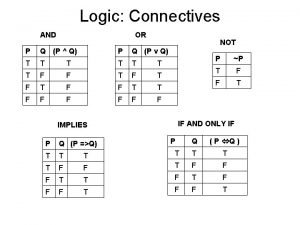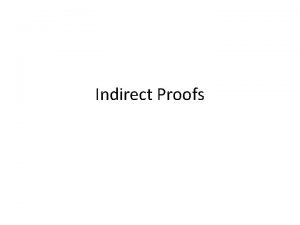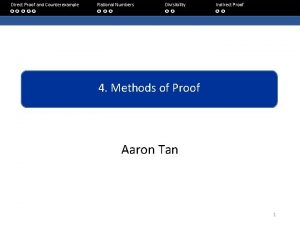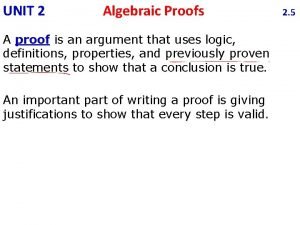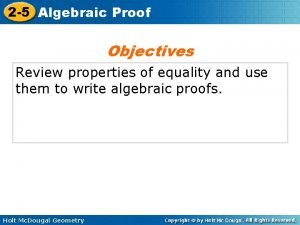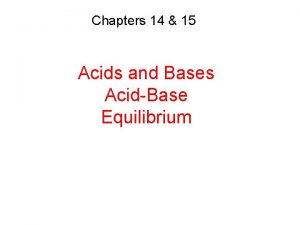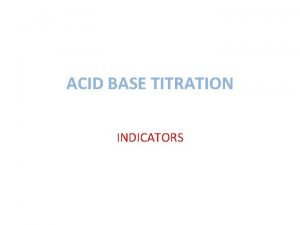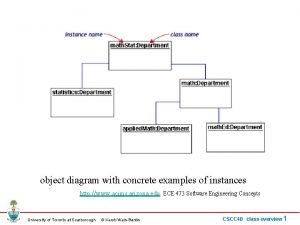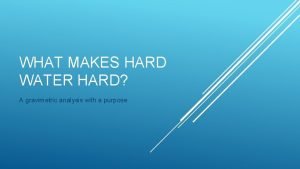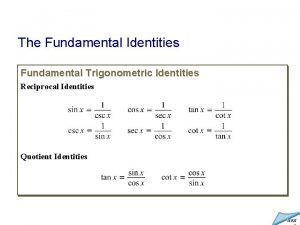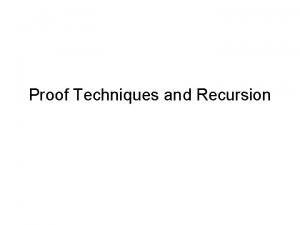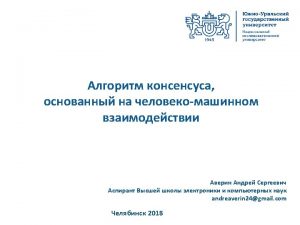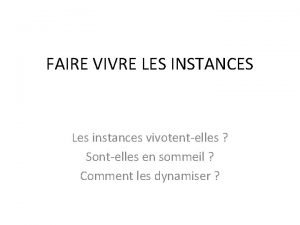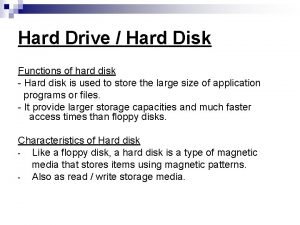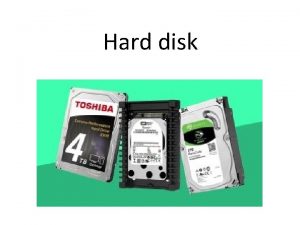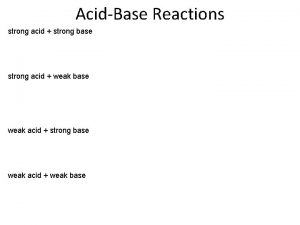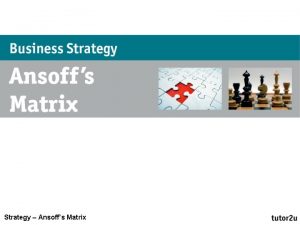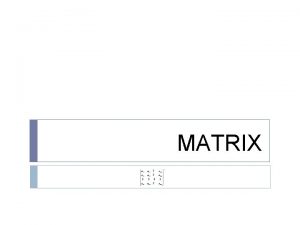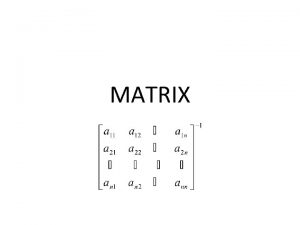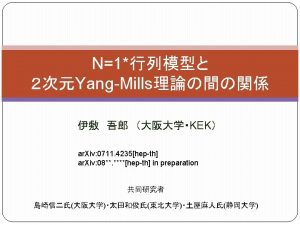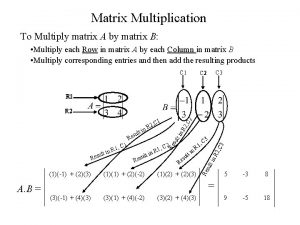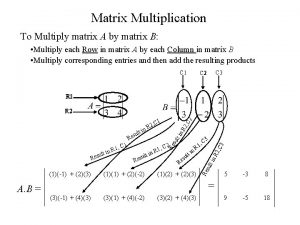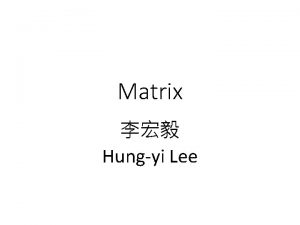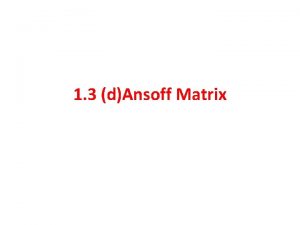Are Matrix Identities Hard Instances for Strong Proof















































![Consider the set of identities over Matd[F]. Kemer ‘ 87: Identities of Matd[F] can Consider the set of identities over Matd[F]. Kemer ‘ 87: Identities of Matd[F] can](https://slidetodoc.com/presentation_image_h/0d8569f17dae9fb54479e079260b1ce9/image-48.jpg)
![Example for d=1 case (Mat 1[F]): All identities of Mat 1[F] can be generated Example for d=1 case (Mat 1[F]): All identities of Mat 1[F] can be generated](https://slidetodoc.com/presentation_image_h/0d8569f17dae9fb54479e079260b1ce9/image-49.jpg)


![THE CASE OF MATD[F] FOR D>1 For d>1, what are the identities of Matd[F] THE CASE OF MATD[F] FOR D>1 For d>1, what are the identities of Matd[F]](https://slidetodoc.com/presentation_image_h/0d8569f17dae9fb54479e079260b1ce9/image-52.jpg)
![MATD[F] FOR D=2 Thm (Drenski 1981): For char(F)=0, all identities of Mat 2(F) are MATD[F] FOR D=2 Thm (Drenski 1981): For char(F)=0, all identities of Mat 2(F) are](https://slidetodoc.com/presentation_image_h/0d8569f17dae9fb54479e079260b1ce9/image-53.jpg)
![MAT 2[F] • 54 MAT 2[F] • 54](https://slidetodoc.com/presentation_image_h/0d8569f17dae9fb54479e079260b1ce9/image-54.jpg)



- Slides: 57

Are Matrix Identities Hard Instances for Strong Proof Systems? Iddo Tzameret Royal Holloway, and University of London Tsinghua University (Joint work with Fu Li)

STRONG PROOF SYSTEMS: CURRENT AFFAIRS Best lower bound: No non-trivial conditional lower bounds No non-explicit lower bounds No hard candidates (almost) 2 Ω(n ) 2

WE PROPOSE New algebraic technique to lower bound strong arithmetic or propositional proof systems (e. g. Extended Frege) Identify new natural hard candidates 3

IN A NUTSHELL Propose matrix identities as hard candidates for strong proof systems Matrix identity: (non-commutative) polynomial that vanishes over matrices of a given dimension Give some lower bounds Formulate a natural conjecture to realize fully our approach 4

MATRIX IDENTITIES 5

• (Commutative) polynomials • Formal sum of (commutative) monomials (order of multiplication doesn’t matters). • Example: The commutator [X, Y]: =XY-YX is the zero polynomial 6


• Non-commutative polynomials: • Formal sum of non-commutative monomials (order of multiplication matters). • Example: The commutator XY-YX is a non-zero polynomial 8

MATRIX IDENTITIES Matd(�� ) : = d⨯d matrices over field ��. Assume �� is of characteristic 0 (e. g. rationals) A matrix identity f(x 1, …, xn) of Matd(�� ) is a non-commutative polynomial over x 1, . . . , xn that is zero for all assignments of matrices: for all vectors a of d⨯d matrices: f(a)=0 9

MATRIX IDENTITIES Example: xy-yx is a nonzero noncommutative polynomial, but it's not an identity of Matd(�� ) (when d>1): 10

MATRIX IDENTITIES • 11

BIRD’S EYE VIEW OF OUR APPROACH 12

13

Extended Frege ≤p Arithmetic proofs (Hrubes & T. ‘ 09, ’ 12) ≤p Mat 2(F) proofs ≤p Mat 3(F) proofs 14

ARITHMETIC PROOF SYSTEMS 15

ARITHMETIC PROOFS Establish (commutative) polynomial identities Proof-lines: equations between algebraic circuits Axioms: polynomial-ring axioms Rules: Transitivity of “=“; +, x introduction, etc. Circuit-axiom: F=G, Rules: if F and G are identical when the circuits are unwinded into trees Axioms: 16

ARITHMETIC PROOFS field identities axiom commutativity axiom x=x 2∙ 3=6 reflexivity axiom product rule 3 x∙ 2=2∙ 3 x=6 x transitivity 3 x∙ 2=6 x 17

ARITHMETIC PROOFS By Rekchow’s theorem: Over GF(2) (and plausibly over the integers) arithmetic proofs are also propositional proofs of the translated tautology 18

PROOF SYSTEMS FOR Matd(�� ) – Identities 19

BASIS OF MATRIX IDENTITIES A finite basis B={g 1, . . . , gm} of the identities of Matd(F) is a set of non-commutative polynomials that generate all possible identities of Matd(F) (we can also substitute variables x 1, . . , xn by polynomials): Every identity f of Matd(F) can be written as: for some polynomials qi’s, ti’s and pi’s. 20

) ARITHMETIC PROOFS FOR Matd(�� Simply replace the commutativity axiom Axioms: Basis of Matd(�� )– identities By Kemer ’ 87 there is always a finite basis 21

LOWER BOUNDS FOR Matd(�� )–PROOFS 22

COMPLEXITY MEASURE QB(f)=min k such that: Basis of Mat ( ) � d � B={g 1, …, g } m I. e. , how many substitution instances of generators from basis B needed to generate an identity of Matd(�� )? 23

OUR LOWER BOUND Generalize Hrubes (‘ 11) for d=1 • It’s open to find bases for Matd(�� ) Proof idea: (“the Specht problem”) 1. Use Amitsur-Levitzki Theorem (1950); 2. Counting argument; Extension of Hrubes (‘ 11) 3. Use other structural properties of Matd(�� ) identities. 24

COROLLARY • 25

TOWARDS ARITHMETIC PROOFS LOWER BOUNDS 26

Extended Frege ≤p Arithmetic proofs (Hrubes & T. ‘ 09, ’ 12) ≤p Mat 2(F) proofs ≤p Mat 3(F) proofs 27

TRANSLATING MATRIX IDENTITIES Matrix identity f of Matd(F) set of d 2 (commutative) polynomial identities over variables X. Example: X·Y=I Treat X, Y as 2 x 2 matrices: • Now can use arithmetic proofs to prove the four equations ! 28

CONJECTURE Conjecture: For any fixed d, and a circuit equation G=0 computing a matrix identity g=0, the minimal size of an arithmetic proof of the d 2 corresponding identities of G=0 is Ω(QB(g)). In other words: proving matrix identities of Matd(�� ) entry-wise cannot be faster than “proving” them using substitution instances of the generating sets of Matd(�� ). 29

Intuition: The following are equivalent for proving matrix identities: Reason with variables X 1, . . . , Xn that range over matrices; Reason with variables that range over the entries xijk (for i, j, k [n]) of the matrices X 1, . . . , Xn • • 30

EXPONENTIAL LOWER BOUNDS We can hope for even exponential lower bounds: the dimension d increases with n. 31

CONCLUSIONS 32

Extended Frege ≤p Arithmetic proofs (Hrubes & T. ‘ 09, ’ 12) ≤p Mat 2(F) proofs ≤p Mat 3(F) proofs 33

THANKS FOR LISTENING! QUESTIONS, COMMENTS, SUGGESTIONS, OBJECTIONS?


WHAT’S THE CONNECTION? Observation (Hrubes ’ 11): The minimal arithmetic proof of f=g >= Q 1(hat f-hat g), where hat f is the noncommutative poly computed by circuit f. Proof: By induction on number of lines t in proof. Base: t=1. f=g is an axiom. If f=g not the commutativity axiom, say h+0=h, then hat (h+0)-hat h =0in F<X>. Hence Q 1(0)=0. Otherwise, f=g is the axiom uv=vu, for u, v circuits, and so Q 1(uv-vu)=1. 36

Complexity measure: how many substitution instances of generators are needed to generate an identity for Matd[F] ? The case of d=1: Let Q 1(f) be the minimal number of substitution instances of commutators [x, y] needed to generate identities of Mat 1[F]. i. e. , min k such that f in I<[t 1, t’ 1], …, [tk, t’k]>, for some t’s in F<X>. Example: Q 1(sum_{i, jin n} xixj ) = 1 sum_{i, jin n} xixj = (x 1+…+xn)*(x 1+…+xn) 37

THE LOWER BOUND PROOF 38

What are the hard identities f ? We call it the s-formulas: where For some n fixed fi’s: 39


BY COUNTING • 41

Thus we can assume w. l. o. g. that the substitutions in the generators’ variables are linear forms: 42

Recall: So, total # of possible n-tuples of fi’s: (for each i=1, . . n choose which of the cj’s in fi are 1). 43

total # of n-tuples f 1, …, fn we can generate with q s 2 d-generators: choose 2 d x q linear forms x choose q field elements for coefficients of linear combination: We get: implying: Q. E. D. Assume field is finite. The other case can also be handled. 44

LEMMA Lemma: For any d and polynomials p 1, …, pn: 1. deg > d monomials in pi not counted in LHS 2. Property of s 2 d(x 1, . . , x 2 d): assigning a constant to a variable makes it 0. Thus: • Degree 0 monomial in pi doesn’t contribute to LHS; • Degree >1 monomial in pi can contibute to LHS only if it multiplies a constant in some pj, j≠j. Hence, we get 0 again. 45

THE ALGEBRAIC PROBLEM Let F<X> be the ring of noncommutative polynomials over variables x 1, x 2, … i. e. , every polynomial is a formal sum of noncommutative monomials with coefficients from the field F. E. g. , the commutator [x 1, x 2]: = x 1 x 2 – x 2 x 1 is not the zero polynomial. 46

THE ALGEBRAIC PROBLEM Let A be a (not necessarily commutative, but associative) F -algebra. E. g. : the dxd matrix algebra Matd( ). An identity of A is a noncommutative polynomial f(x 1, . . , xn) in F<X>, , where for all vectors a from An, f(a)=0. E. g. : x 1 x 2 – x 2 x 1 is an identity of Mat 1( F ) (but not of Matd( ) if d>1) 47
![Consider the set of identities over MatdF Kemer 87 Identities of MatdF can Consider the set of identities over Matd[F]. Kemer ‘ 87: Identities of Matd[F] can](https://slidetodoc.com/presentation_image_h/0d8569f17dae9fb54479e079260b1ce9/image-48.jpg)
Consider the set of identities over Matd[F]. Kemer ‘ 87: Identities of Matd[F] can be generated (in the two-sided ideal) by substitution instances of a finite set G of polynomials g 1…gc in F<X I. e. , every identity f in F<X> over Matd(F) can be written as: for some polynomials Qi’s, ti’s and Pi’s in F<X. 48
![Example for d1 case Mat 1F All identities of Mat 1F can be generated Example for d=1 case (Mat 1[F]): All identities of Mat 1[F] can be generated](https://slidetodoc.com/presentation_image_h/0d8569f17dae9fb54479e079260b1ce9/image-49.jpg)
Example for d=1 case (Mat 1[F]): All identities of Mat 1[F] can be generated by substitution instances of a single polynomial: the commutator [x, y]=xy-yx : f is an identity of Mat 1[F] iff f in <[x_i, x_j]: i neq j in N (all ideals are two sided ideals). 49

Complexity measure: how many substitution instances of generators are needed to generate an identity for Matd[F] ? The case of d=1: Let Q 1(f) be the minimal number of substitution instances of commutators [x, y] needed to generate identities of Mat 1[F]. i. e. , min k such that f in I<[t 1, t’ 1], …, [tk, t’k] , for some ti’s in F<X>. Example: Q 1(x 1 x 3 -x 3 x 1+x 2 x 3 -x 3 x 2)=? =1 since: (x 1+x 2)x 3 -x 3(x 1+x 2)=x 1 x 3 -x 3 x 1+x 2 x 3 -x 3 x 2 50

![THE CASE OF MATDF FOR D1 For d1 what are the identities of MatdF THE CASE OF MATD[F] FOR D>1 For d>1, what are the identities of Matd[F]](https://slidetodoc.com/presentation_image_h/0d8569f17dae9fb54479e079260b1ce9/image-52.jpg)
THE CASE OF MATD[F] FOR D>1 For d>1, what are the identities of Matd[F] ? not all cases are known precisely; dates back to Amitzur and Levitski 1950. • Some cases are known, some are only conjectured. 52
![MATDF FOR D2 Thm Drenski 1981 For charF0 all identities of Mat 2F are MATD[F] FOR D=2 Thm (Drenski 1981): For char(F)=0, all identities of Mat 2(F) are](https://slidetodoc.com/presentation_image_h/0d8569f17dae9fb54479e079260b1ce9/image-53.jpg)
MATD[F] FOR D=2 Thm (Drenski 1981): For char(F)=0, all identities of Mat 2(F) are generated by s 4 formulas and the hall formulas where and h(x 1, x 2): =[[x 1, x 2]2, x 1] Note: assume from now that char(F)=0. Every identity f in F<X> over Mat 2(F) can be written as: For some polynomials Qi’s, Pi’s and sequences of polynomials gi’s in F<X>. 53
![MAT 2F 54 MAT 2[F] • 54](https://slidetodoc.com/presentation_image_h/0d8569f17dae9fb54479e079260b1ce9/image-54.jpg)
MAT 2[F] • 54

GENERALIZATION • 55

CONJECTURE • 56

TRANSLATING MATRIX IDENTITIES • 57
 Mikael ferm
Mikael ferm Ephesians 6:10-20 nkjv
Ephesians 6:10-20 nkjv Generating hard instances of lattice problems
Generating hard instances of lattice problems Prove set identities
Prove set identities Sum and differnce formula
Sum and differnce formula Direct proof and indirect proof
Direct proof and indirect proof Direct proof and indirect proof
Direct proof and indirect proof Indirect proof logic
Indirect proof logic Direct proof and indirect proof
Direct proof and indirect proof Unit 2 logic and proof homework 7 algebraic proofs
Unit 2 logic and proof homework 7 algebraic proofs Algebraic proofs examples
Algebraic proofs examples Difference between strong and weak acids
Difference between strong and weak acids Strong acid and strong base titration curve
Strong acid and strong base titration curve How to remember strong acids and strong bases
How to remember strong acids and strong bases Acid base titration curve
Acid base titration curve Weak acid and weak base
Weak acid and weak base Ionic equation of titration
Ionic equation of titration Example of concrete instances
Example of concrete instances Variablat e instances
Variablat e instances Gravimetric analysis of calcium and hard water
Gravimetric analysis of calcium and hard water Work hard, have fun, make history
Work hard, have fun, make history Hard times hard drive
Hard times hard drive Formuö
Formuö Novell typiska drag
Novell typiska drag Nationell inriktning för artificiell intelligens
Nationell inriktning för artificiell intelligens Returpilarna
Returpilarna Varför kallas perioden 1918-1939 för mellankrigstiden
Varför kallas perioden 1918-1939 för mellankrigstiden En lathund för arbete med kontinuitetshantering
En lathund för arbete med kontinuitetshantering Särskild löneskatt för pensionskostnader
Särskild löneskatt för pensionskostnader Tidbok för yrkesförare
Tidbok för yrkesförare A gastrica
A gastrica Förklara densitet för barn
Förklara densitet för barn Datorkunskap för nybörjare
Datorkunskap för nybörjare Stig kerman
Stig kerman Debatt mall
Debatt mall För och nackdelar med firo
För och nackdelar med firo Nyckelkompetenser för livslångt lärande
Nyckelkompetenser för livslångt lärande Påbyggnader för flakfordon
Påbyggnader för flakfordon Vätsketryck formel
Vätsketryck formel Svenskt ramverk för digital samverkan
Svenskt ramverk för digital samverkan Jag har nigit för nymånens skära
Jag har nigit för nymånens skära Presentera för publik crossboss
Presentera för publik crossboss Argument för teckenspråk som minoritetsspråk
Argument för teckenspråk som minoritetsspråk Bat mitza
Bat mitza Treserva lathund
Treserva lathund Mjälthilus
Mjälthilus Claes martinsson
Claes martinsson Cks
Cks Programskede byggprocessen
Programskede byggprocessen Bra mat för unga idrottare
Bra mat för unga idrottare Verktyg för automatisering av utbetalningar
Verktyg för automatisering av utbetalningar Rutin för avvikelsehantering
Rutin för avvikelsehantering Smärtskolan kunskap för livet
Smärtskolan kunskap för livet Ministerstyre för och nackdelar
Ministerstyre för och nackdelar Tack för att ni har lyssnat
Tack för att ni har lyssnat Mall för referat
Mall för referat Redogör för vad psykologi är
Redogör för vad psykologi är Matematisk modellering eksempel
Matematisk modellering eksempel


